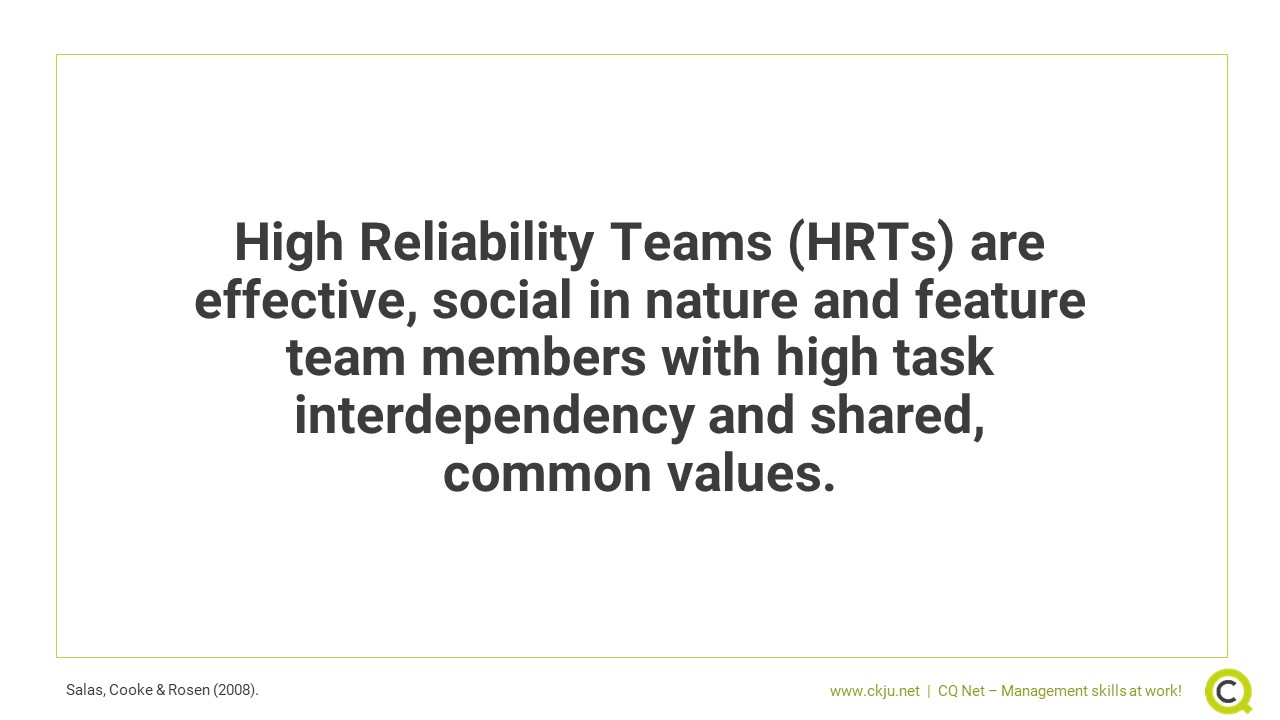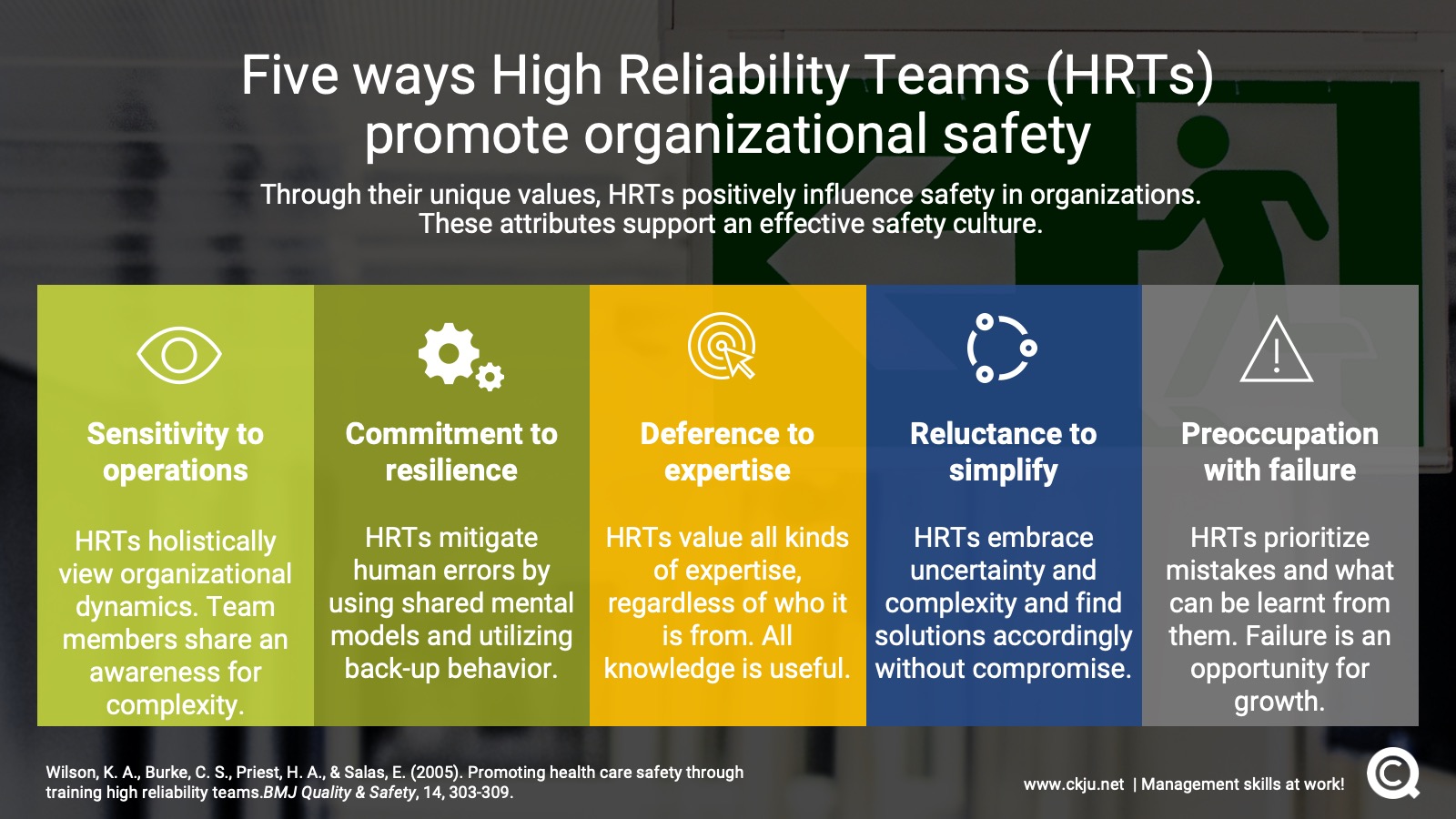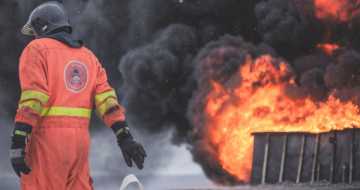- All Management Learning Resources
- High Reliability Teams

Why you should care about High Reliability Teams
How can organizations effectively use High Reliability Teams to promote safety? High Reliability Teams have the ability to promote safety through task-relevant knowledge, high levels of communication, and adapting to the environment. Such teams are effective, social in nature and feature team members with high task interdependency and shared, common values (Salas, Cooke & Rosen, 2008). Due to their special features, High Reliability Teams help promote safety at the workplace and are therefore valuable assets for organizations.
Contents
- Why you should care about High Reliability Teams
- What is a High Reliability Team (HRT)?
- What are the characteristics of High Reliability Teams (HRTs)?
- HRTs utilize the benefit of groups over individual strengths
- HRTs are a crucial component of an organizational safety climate
- Key recommendations for professionals
- References and further reading
What is a High Reliability Team (HRT)?
Research shows that the most effective organizations are those that balance safety with competing factors such as productivity and work pace (Neal & Griffin, 2004). There exist several organizations that demonstrate excellent safety effectiveness.
These organizations that are typically found within complex environments such as the aviation and nuclear power industry are described as High Reliability Organizations (HROs) (Weick and Sutcliffe 2015). The teams that work within these High Reliability Organizations are categorized as High Reliability Teams (HRTs).
HRTs benefit organizational safety with their inherent characteristics
Indeed, recent changes in technology and innovation have resulted in many organizations using teams as a tool to achieve organizational outcomes such as safety and productivity (Salas et al., 2008). Unfortunately, research conducted on teams within complex environments has shown that not all teams were effective. HRTs are a positive example of teams being able to operate in a VUCA environment. In addition, they have the benefit of influencing the fabric of organizations, which results in a better safety climate and helps reduce workplace risks.
What are the characteristics of High Reliability Teams (HRTs)?
According to Wilson et al. (2005), the five values that reflect how HRTs promote safety within High Reliability Organizations. At the team level, there are certain behavioral indices that reflect each of these values. The five values are:
- sensitivity to operations
- commitment to resilience
- deference to expertise
- reluctance to simplify
- and preoccupation with failure.
Sensitivity to operations: sharing awareness and enhancing decision-making
To demonstrate sensitivity to operations, HRTs must use closed loop communication to promote shared awareness regarding safety factors that are important within each team and within the organization. This involves HRTs having a holistic view of safety within a complex organizational environment. A closed loop communication involves the team’s ability to exchange clear information and to acknowledge receipt and understanding of the information. For example, in a hospital if a patient is transferred from the emergency room to surgery, it is important that all vital information about the patient is relayed and received accurately (Wilson et al., 2005).
A sensitivity to operations also includes HRTs having shared awareness of the importance of improving workplace safety. This can involve alerting other team members of latent errors and using strategies that enhance decision-making regarding safety (Wilson et al, 2005). One example is of a group of surgeons who share situational awareness and can perceive future issues before they escalate into a more critical situation.
Commitment to resilience: balancing out human error
One of the reasons that HRTs are effective is that they demonstrate a commitment to resilience through mitigating the consequences of human error. The consequences of human error in HROs is damaging and HRTs engage in several activities to avoid negative outcomes including team members asking for help when overloaded, monitoring each other’s performance, and assisting other team members who need help.
These outcomes are obtained through effective teamwork behaviors such as back-up behavior and development of team mental models. An example of this is within a hospital where doctors and nurses work together to ensure the safety and health of their patients (Wilson et al., 2005).
Deference to expertise: valuing everyone's knowledge
Rather than using status or member rank, HRT members use expertise as a source of power to determine value to the group. This means that they recognize the value of knowledge, regardless of the position of the team member within the organization. HRTs recognize that the knowledge or actions of one team member are important to consider in decision-making regarding safety.
Consequently, there is the acknowledgment that senior members do not always hold the solutions to problems and that junior team members might hold more novel or innovative knowledge that is relevant to problems. This deference to expertise is egalitarian in that it allows all team members to be included in decision-making, regardless of position.
Reluctance to simplify: embracing complexity and flexibility
HRTs recognize the complexities in the work environment and develop plans that promote flexibility. Although this leads to simplification, HRT members recognize that it is important to retain complexity in decision-making so that intricacies such as safety protocols are not ignored.
This reluctance to simplify manifests in careful planning before procedures such as in aviation conducting a preflight briefing before departing on a flight. HRTs also process information to ensure that it is consistent with expectations so that valid action is taken. This ensures that HRTs remain flexible and adaptable in all situations to ensure safety.
Preoccupation with failure: learning from mistakes
A quality of HRTs is that they learn from their mistakes and use techniques such as team self-correction. Many accidents occur through errors so members of HRTs monitor their own and other’s behaviors during an event to discuss their performance.
They provide and seek constructive feedback to reflect on what was done correctly. HRTs also demonstrate a preoccupation with failure by encouraging team members to report incidents that did not result in a reportable accident. This takes the form of voluntary, non-punitive reporting systems.
HRTs utilize the benefit of groups over individual strengths
Decades of team-based research has demonstrated that teams are more effective than the sum of individual effort (Salas, Reyes & McDaniel, 2018). HROs have long recognized that teams - and concretely HRTs - can take on more involved work than individuals and can combine their abilities to provide backup behavior, thereby mitigating human error within the organization. This particular characteristic of HRTs ensures that team members can monitor each other to reduce errors and thereby increase safety in the work environment.
HRTs are a crucial component of an organizational safety climate
Due to their particular characteristics and their positive impact on safety, HRTs are a fundamental component of attaining a safety climate that is optimal for organizations. Such a climate is characterized by the shared perceptions among organizational members of safety policies, procedures and practices (Wallace, Popp & Mondore, 2006). HRTs reflect the values of their organizations, which show a commitment to excellence and safety.
Key recommendations for professionals
- High Reliability Teams (HRTs) influence organizations as a whole and positively impact safety
- Particularly organizations in complex complex environments such as the nuclear industry, healthcare, and the oil industry can benefit from the inherent characteristisc of HRTs
- There are five characteristics of HRTs that positively impact safety in organizations:
- HRTs are sensitive to operations
- HRTs demonstrate a commitment to resilience
- HRTs rely on team member expertise rather than on position
- HRTs demonstrate a reluctance to simplify to ensure procedures are safe
- HRTs are preoccupied with failure to minimize human errors
- HRTs are crucial tools in attaining a safety culture in an organization and should therefore be invested into
Management skills newsletter
Join our monthly newsletter to receive management tips, tricks and insights directly into your inbox!
References and further reading
Neal A., & Griffin M.A. (2004). Safety climate and safety at work. In: Frone M.R., Barling J., (editors). The Psychology of Workplace Safety. American Psychological Association; Washington, DC.
Salas, E., Cooke, N. J, & Rosen, M. A. (2008). On teams, teamwork, and team performance: Discoveries and Developments. Human Factors, 50, 3, 540-547.
Salas, E., Reyes, D. L., & McDaniel, S. H. (2018). The Science of Teamwork: Progress, Reflections, and the Road Ahead. American Psychologist, 73, 4, 593-600.
Wallace, J. C., Popp, E., & Mondore, S. (2006). Safety climate as a mediator between foundation climates and occupational accidents: A group-level investigation. Journal of Applied Psychology, 91(3), 681-688.
Weick, Karl E.; Sutcliffe, Kathleen M. (2015): Managing the Unexpected: Sustained Performance in a Complex World. 3rd Edition: Wiley.
Wilson, K. A., Burke, C. S., Priest, H. A., & Salas, E. (2005). Promoting health care safety through training high reliability teams.BMJ Quality & Safety, 14, 303-309.
About the Author








